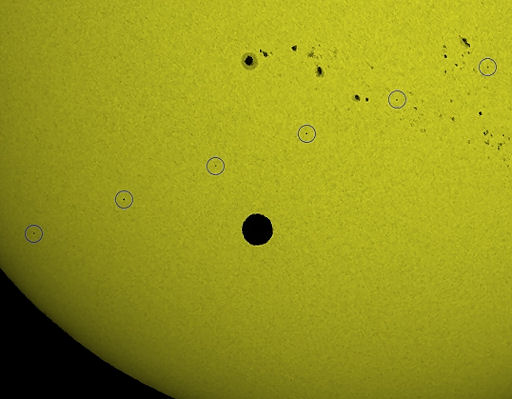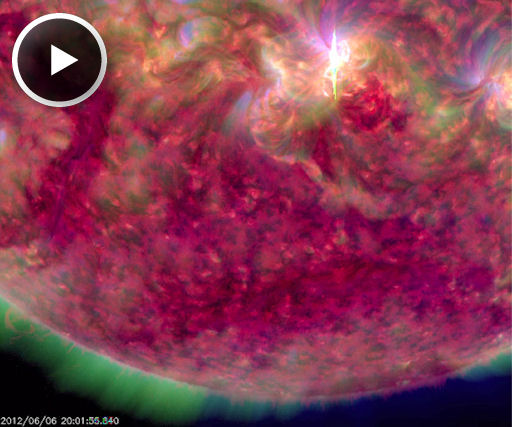SUBSIDING SOLAR WIND: A fast stream of solar wind that has been buffeting Earth's magnetic field is beginning to subside. Nevertheless, NOAA forecasters estimate a 30% chance of geomagnetic storms around the poles on June 8th. Magnetic storm alerts: text, voice.
HUBBLE TRANSIT OF VENUS: One of the big ironies of the 2012 Transit of Venus was that NASA's greatest telescope didn't dare photograph the event. Hubble's instruments are so sensitive, one look at the glaring sun would have crippled its instruments. Nevertheless, Hubble managed to join the show. Astrophotographer Theirry Legault caught the observatory flitting in front of the sun alongside Venus:
"I was in north-east Australia for the full transit of Venus and a transit of Hubble in the middle," says Legault. "My Nikon D4 digital camera was working at 10 fps on a Takahashi FSQ-106ED telescope to record 9 images of HST during its 0.9s transit."
This is certainly an historic photo. Imagine what James Cook would think of a telescope in space crossing his field of view as he watched the transit of 1769 from a beach in Tahiti. Moreover, imagine what kind of telescopes will be crossing the sun when the next Transit of Venus occurs in 2117. Congratulations to Legault for capturing a truly rare 0.9s slice of history.
More slices of history may be found in the Transit of Venus Photo Gallery:
Realtime Transit of Venus Photo Gallery
[Submit your photos] [NASA videos: 2012 Transit of Venus, ISS Transit of Venus]
Transit of Venus Web Links:
- NASA's Transit of Venus home page
- James Cook and the Transit of Venus -- Science@NASA
- Don Pettit and the Transit of Venus -- Science@NASA
CHANCE OF FLARES: The odds of a significant solar flare are improving as three sunspots develop complex magnetic fields with energy for M-class eruptions. NASA's Solar Dynamics Observatory recorded this extreme ultraviolet flash (category M3) from sunspot AR1494 on June 6th:
The impulsive flare hurled a coronal mass ejection into spacce, but not directly toward Earth. The cloud should sail mostly south of our planet on June 8-9.

![]()
Solar wind
speed: 535.8 km/sec
density: 1.1 protons/cm3
explanation | more data
Updated: Today at 1457 UT
![]()
X-ray Solar Flares
6-hr max: B8 1124 UT Jun08
24-hr: C7 0307 UT Jun08
explanation | more data
Updated: Today at: 1500 UT
![]()
![]()
![]()
Daily Sun: 07 Jun 12
![]()
![]()
Sunspot 1494 poses a threat for M-class eruptions. Credit: SDO/HMI
![]()
![]()
![]()
Sunspot number: 98
What is the sunspot number?
Updated 06 Jun 2012
Spotless Days
Current Stretch: 0 days
2012 total: 0 days (0%)
2011 total: 2 days (<1%)
2010 total: 51 days (14%)
2009 total: 260 days (71%)
Since 2004: 821 days
Typical Solar Min: 486 days
Updated 06 Jun 2012
The Radio Sun
10.7 cm flux: 140 sfu
explanation | more data
Updated 06 Jun 2012
![]()
![]()
![]()
Current Auroral Oval:
![]()
Switch to: Europe, USA, New Zealand, Antarctica
Credit: NOAA/POES
![]()
![]()
![]()
Planetary K-index
Now: Kp= 1 quiet
24-hr max: Kp= 3 quiet
explanation | more data
![]()
Interplanetary Mag. Field
Btotal: 5.0 nT
Bz: 0.6 nT north
explanation | more data
Updated: Today at 1456 UT
![]()
![]()
![]()
Coronal Holes: 07 Jun 12
![]()
![]()
Earth is inside a high-speed stream of solar wind flowing from this coronal hole. Credit: SDO/AIA.






